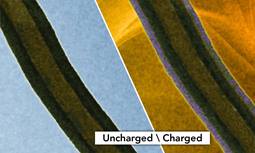Building a Better Battery
 Image courtesy of Environmental Molecular Sciences Laboratory
Image courtesy of Environmental Molecular Sciences Laboratory
Bright-field TEM images taken at EMSL revealed the structural evolution of the Si-coated carbon fiber nanocomposite’s complex phase transformation during cyclic charging and discharging.
Ever wonder what happens inside a battery that allows the light to turn on and the engine to turn over? Scientists do.
In fact, researchers at the Environmental Molecular Sciences Laboratory (EMSL), a national scientific user facility operated by the Office of Sciences' Pacific Northwest National Laboratory (PNNL) have developed a technique to study how batteries work when they're working, under operating conditions (also called in situ). The technique reveals what is happening inside batteries at microscopic scales, and researchers are using this capability to test new materials to build even better batteries.
Lithium-ion (Li-ion) batteries are used in many battery-powered devices, such as cell phones and laptop computers. With improved performance, they hold promise for use in electric vehicles and other energy-storage requirements, such as storing solar–generated electricity until needed. Li-ion batteries are an efficient way to store energy, but they require frequent recharging, have to be periodically replaced and are expensive to produce. To help solve these problems and others, scientists needed to understand how batteries work and why they gradually wear out.
New Capabilities
In 2008, EMSL Senior Scientist Chongmin Wang and a team of researchers from EMSL, PNNL and Hummingbird Scientific LLC began using EMSL facilities to develop in situ microscopy capabilities to observe an operating battery.
"When we started our research, if you wanted to study a battery you dismantled it and observed the structure," said Wang. "The ideal way to study a battery is in situ—or as it is operating in real-world conditions. That way you can see how it functions."
Within two years, the team developed what is essentially "the smallest working battery in the world" (see "Scientists Create World's Smallest Battery"). The small size enabled in situ transmission electron microscopy (TEM) imaging of the electrode during the battery's operation. The technique greatly benefitted from the on-going battery research supported by PNNL and the Department of Energy's Office of Science and applied energy program.
The team's in situ TEM capability is available to other scientists through EMSL's user proposal system. Researchers worldwide have adopted the in situ TEM technique.
Testing Other Materials
The team's initial in situ TEM battery testing capability used a SnO2 anode to test the tool. The team's success with the SnO2 experiments motivated it to test the next element—silicon. Researchers are replacing the graphite currently used in Li-ion batteries with silicon, because of its higher electrical capacity.
"Silicon in theory is a very good material for Li-ion batteries. In practice, it's difficult to use," said Wang. "During charging, the lithium causes the silicon to expand by up to 400 percent and explode or fall apart. We know silicon is a useful material, but making it work is a difficult issue."
Oak Ridge National Laboratory and General Motors developed a Li-ion battery using carbon-coated fiber with amorphous silicon. In 2011, they began collaborating with researchers from EMSL, PNNL, Stanford University and Applied Science Inc. The group tested the micro-battery in situ at EMSL and found the silicon-carbon material worked better than silicon alone. The addition of carbon sped up the charging process. Unfortunately, the silicon expansion problem during charging still occurred.
The team's silicon-carbon research could lead to longer-lasting, cheaper batteries. Their findings were featured in the journal Nano Letters, and TEM videos showing the charge/discharge process generated considerable interest.
[q:media id="{1D868787-EA69-4287-902C-24D063399380}" width="512" height="288"]
"I want to find efficient ways to store energy," said Wang. "Lithium-ion batteries are one of best examples—currently it's a good technology. But we need to understand it more, and along the way we might find new technologies to store energy even better."
The Department's Office of Science is the single largest supporter of basic research in the physical sciences in the United States, and is working to address some of the most pressing challenges of our time. For more information about the labs mentioned, please visit EMSL http://www.emsl.pnnl.gov, PNNL http://www.pnl.gov and Oak Ridge National Laboratory http://www.ornl.gov.
John Nicksich is a Communications Specialist with EMSL, located at PNNL in Richland, Wash.


